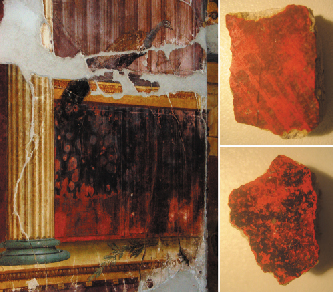- Home
- Users & Science
- Scientific Documentation
- ESRF Highlights
- ESRF Highlights 2006
- X-ray Imaging and Optics
- Blackening of Pompeian cinnabar paintings elucidated using X-ray microfluorescence
Blackening of Pompeian cinnabar paintings elucidated using X-ray microfluorescence
Pompeii and surrounding cities are a valuable treasure of our cultural heritage as they give a frozen image of the every-day life in the Roman Empire at the beginning of the 1st century. Unfortunately, some of the beautiful wall paintings that contribute to the Pompeian reputation are suffering badly from degradation. Mercury sulfide (HgS), commonly named cinnabar, is a deep red pigment, extensively used to cover the background of paintings. It participates in the highly-coloured rendering of the decoration. Yet, in certain circumstances, it can become unstable, turning into dull grey-black shades (Figure 137). Several samples of wall painting were taken from both altered and unaltered areas and submitted to microanalyses in order to shed light on this dramatic blackening (Figure 137).
 |
|
Fig. 137: Left, photo of a degraded wall painting in Villa di Poppea, Oplonti. Right, photos of the studied samples. |
The common assumption proposed to explain this phenomenon is the phase transformation of red cinnabar into black meta-cinnabar by the action of light. Different analyses were performed at the ID21 beamline to tackle this problem.
The elements present in both well preserved and altered samples were identified. In addition to the sulphur and mercury originating from the pigment, and the calcium present as calcite in the mortar, minor exogenous elements were detected. Among them, aluminium, silicon, potassium and more interestingly chlorine. Micro X-ray fluorescence signals were then mapped over pink, grey or black surfaces. Thus, the elemental distributions were directly correlated to the visible appearance of paintings. In particular, the chlorine map matched a grey alteration perfectly. X-ray absorption spectroscopy at the chlorine K-edge was performed to assess its chemical environment. Chlorine was found to be associated with sodium and mercury. Indeed, chlorine is known to foster the cinnabar sensitivity to light and its consecutive darkening [1]. Two sources of NaCl have been suggested: the vicinity of the sea (samples studied here come from “Villa Sora” in Torre del Greco which is at the seashore) and the probable use of a particular protective mixture – the so-called “Punic Wax” – which, according to Plinius the Elder, was made by the use of seawater.
All these observations explain the deep lilac-grey aspect observed on some samples. Yet, analyses performed on another part of the painting, with a darker appearance, show a high accumulation of sulphur without chlorine. X-ray absorption spectroscopy at the sulphur K-edge revealed the speciation of sulphur and refutes the hypothesis of a phase transformation into meta-cinnabar. Amazingly, instead of this suspected phase, another compound was identified: calcium sulphate, namely gypsum. So, instead of a “simple” phase transition, sulphur was subject to a real oxidation going from a reduced sulphide (S(-II)) to an oxidised sulphate (S(+VI)) state. Most presumably, this gypsum (CaSO4.2H2O) results from the reaction of SO2 with the calcite (CaCO3) present in the mortar. This assumption is supported by the fact that, chlorine, whose role has already been mentioned in the darkening process, can also catalyse the linkage reaction HgS ![]() Hg + S, thus providing a source of sulphur for further reactions with the oxygen of air and the final formation of SO2.
Hg + S, thus providing a source of sulphur for further reactions with the oxygen of air and the final formation of SO2.
Having identified the various sulphur compounds as markers of degradation, an additional in–depth analysis was performed. A sample was embedded in resin and polished perpendicularly to the painted layer. In this way, all the painting stratigraphy was accessible from the mortar to the surface. The pigmented layer was of only 100 µm deep rendering the use of the micro-probe essential. Micro-X-ray fluorescence was recorded with several exciting energies. Figure 138 shows that oxidised sulphur species, sulphates, are present in a very thin superficial layer of about 5 µm. Below this, a thick layer of intact cinnabar is still present.
 |
|
Fig. 138: Elemental and chemical maps in a cross-section of a degraded fragment. Map size 95 x 60 µm2. |
In conclusion, this experiment refutes the classical explanation proposed for cinnabar blackening. Instead, a complex pathway involving the reaction of both chlorine and sulphur dioxide has been demonstrated. This study exploits the high spatial resolution, low detection limit and high chemical sensitivity provided at the ID21 X-ray microscope. A complete elucidation of this phenomenon will require the analysis of a wider range of samples originating from various environmental situations, for example inside or outside, exposed to various climates and with or without a protecting overlayer. In particular, the possible action of micro-organisms in this set of complex chemical reactions has to be addressed.
References
[1] J.K. McCormack, Miner. Deposita, 35, 796-798, (2000).
Principal Publication and Authors
M. Cotte (a), J. Susini (a), N. Metrich (b), A. Moscato (c), C. Gratziu (c), A. Bertagnini (d), M. Pagano (e), Anal. Chem., (2006).
(a) ESRF
(b) Laboratoire Pierre Süe, CEA-CNRS, Saclay (France)
(c) Dipartimento di Scienze della Terra, Pisa (Italy)
(d) Istituto Nazionale di Geofisica e Vulcanologia, Pisa (Italy)
(e) Soprintendenza per i Beni Archeologici del Molise, Campobasso (Italy)



